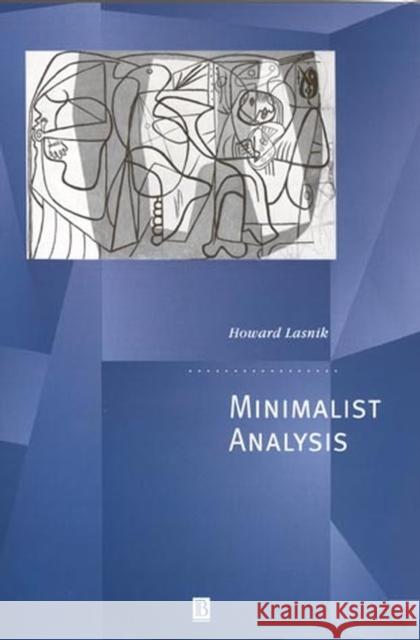Minimalist Analysis » książka



(netto: 262,74 VAT: 5%)
Najniższa cena z 30 dni: 274,18
ok. 30 dni roboczych
Dostawa w 2026 r.
Darmowa dostawa!
This volume presents an introduction to the basic ideas and concepts of minimalism, arguably the most important recent development in syntax.
"Howard Lasnik has a knack for taking very abstruse ideas and teasing delightful empirical consequences from them. In this collection of essays he applies this talent to current Minimalist theory. In the process he explicates and refines core technical notions of the Minimalist enterprise and lays bare its larger logic. For those intrigued by Minimalism but who aren t quite sure how to "do it" I can think of no better advice than the following: read these essays and imitate shamelessly!"
Norbert R. Hornstein,
University of Maryland
"Minimalist Analysis highlights and sharpens the empirical focus of work on Chomsky s Minimalist program. Lasnik s investigations of a broad range of syntactic phenomena elucidate the central concepts and analyses of Minimalism and motivate some significant modifications. These clear and insightful case studies illuminate the complex interactions between theory and data. This is an outstanding collection and an important resource for linguistic theory." Robert Freidin, Princeton University
Preface.
Original Publication Details.
Part I: Introduction.
Part II: On the Subject of Infinitives (with Mamoru Saito):.
1. Introduction.
2. Evidence for Raising.
3. When Does Raising Take Place?.
4. Postal′s B–Verbs vs. W–Verbs: Raising Questions.
Part III: Lectures on Minimalist Syntax:.
5. Introduction.
6. Levels of Representation: Case Considerations.
7. The "Extended Projection Principle".
8. Case and Expletives.
9. [Spec, Agr]: Further Arguments.
10. The Problem of Apparent S–structure Requirements.
11. Antecedent Contained Deletion.
12. More on Reconstruction.
13. The PRO Theorem Reconsidered.
14. Some Remaining Issues.
Part IV: Case and Expletives Revisited: On Greed and Other Human Failings:.
15. Introduction.
16. Greed.
17. An Alternative to Greed: Enlightened Self Interest.
18. The Nature of "Partitive" Case.
19. The Structure of Inherent Case.
20. Conclusion.
Part V: Verbal Morphology: Syntactic Structures Meets the Minimalist Program:.
21. Introduction.
22. French vs. English.
23. An Economy Approach.
24. A Minimalist–Lexicalist Approach.
25. A Hybrid Approach.
26. Further Evidence from VP Ellipsis.
27. Conclusion.
Appendix.
Part VI: Last Resort:.
28. The Driving Force for A–Movement.
29. Greed.
30. Existential Constructions.
31. Enlightened Self–Interest.
32. LF Feature Movement.
33. Raising to [Spec, Agr]: Covert or Overt?.
34. Conclusion.
Part VII: A Note on Pseudogapping:.
35. Introduction.
36. Pseudogapping as Remnant Raising Plus BP Ellipsis.
37. Strong Features and PF Deletion.
38. PPs as Remnants.
39. Multiple Complements.
40. (Some Instances of) Pseudogapping as Parallel to Pseudogapping.
41. Conclusion.
Part VIII: On Certain Structural Aspects of Anaphora:.
42. Introduction.
43. Where Do the Binding Conditions Apply?.
44. Feature Movement and (Lack of) Binding.
45. Overt Raising to [Spec, Agr].
46. Feature Movement and Control?.
47. Inherent Case as "Structural"?.
48. A Puzzling Divorce of Binding and Scope.
Bibliography.
Index.
Howard Lasnik is Professor of Linguistics at the University of Connecticut. He has played a prominent role in syntactic theorizing from the extended Standard Theory, through Government–Binding Theory, to Minimalism. He is the author of Move Alpha: Conditions on Its Application and Output (with Mamoru Saito), 1992; An Invitation to Cognitive Science, Vol. 1, Language (with Daniel Osherson), 1990; Essays on Restrictiveness and Learnability, 1990; Essays on Anaphora, 1989; and A Course in GB Syntax: Lectures on Binding and Empty categories (with Juan Uriagereka), 1988. He is also editor, with Daniel Osherson, of An Invitation to Cognitive Science, Vol. 1, Language (1990).
This volume presents an introduction to the basic ideas and concepts of minimalism, arguably the most important recent development in syntax.
It succeeds in bringing together theoretical discussion of the concepts and techniques of the minimalist approach to syntax, and detailed empirical studies, some on phenomena that have not been investigated in recent syntactic frameworks.
Minimalist Analysis clearly expounds important new ideas and their motivation, presents interesting new data with a fresh look at some old data, and places current ideas in their historical context.
1997-2025 DolnySlask.com Agencja Internetowa
KrainaKsiazek.PL - Księgarnia Internetowa









